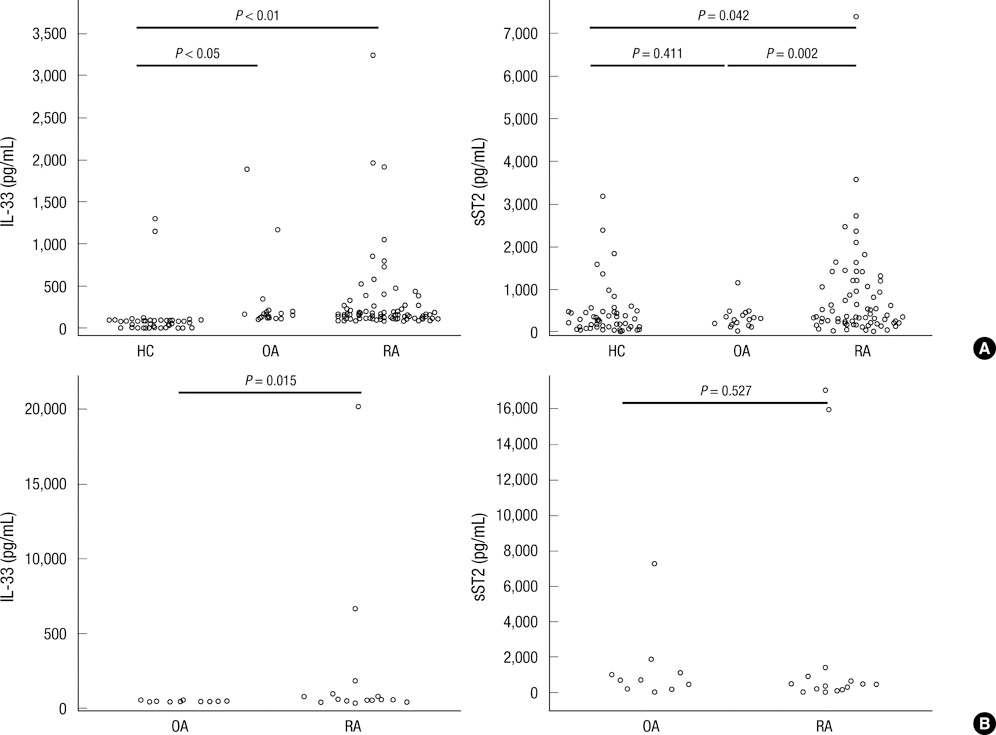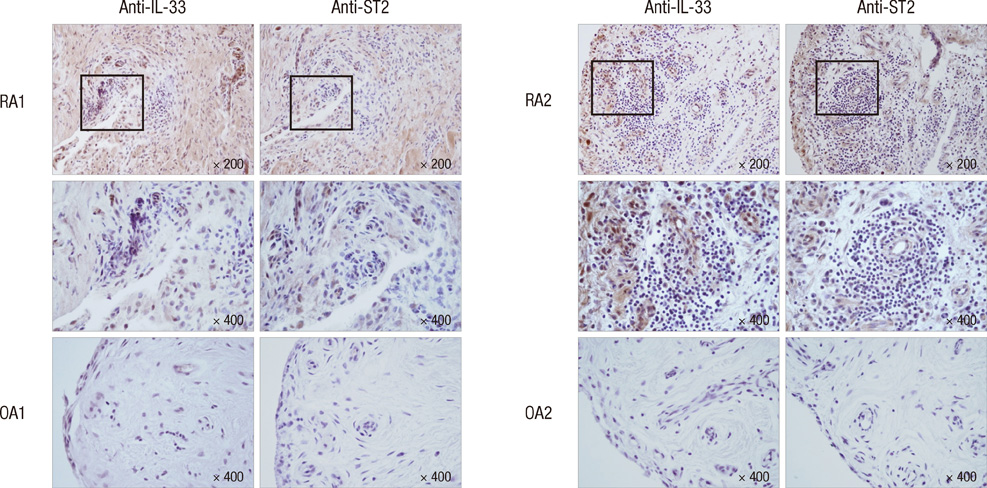J Korean Med Sci.
2011 Sep;26(9):1132-1139. 10.3346/jkms.2011.26.9.1132.
Measurement of Interleukin-33 (IL-33) and IL-33 Receptors (sST2 and ST2L) in Patients with Rheumatoid Arthritis
- Affiliations
-
- 1Division of Rheumatology, Department of Internal Medicine, School of Medicine, The Catholic University of Korea, Seoul, Korea. rmin6403@hanmail.net
- 2Department of Internal medicine, Soonchunhyang University College of Medicine, Bucheon, Korea.
- 3The Rheumatism Research Center, Catholic Research Institute of Medical Science, The Catholic University of Korea, Seoul, Korea.
- KMID: 1779384
- DOI: http://doi.org/10.3346/jkms.2011.26.9.1132
Abstract
- The interleukin-33 (IL-33)/ST2 pathway has emerged as an intercellular signaling system that participates in antigen-allergen response, autoimmunity and fibrosis. It has been suggested that IL-33/ST2 signaling has been involved in the pathogenesis of rheumatoid arthritis (RA), because IL-33 and its receptor have been specifically mapped to RA synovium. The aim of this study was to determine the levels of IL-33 and sST2 in sera and synovial fluids in patients with RA. The serum level of IL-33 was significantly higher in patients with RA (294.9 +/- 464.0 pg/mL) than in healthy controls (96.0 +/- 236.9 pg/mL, P = 0.002). The synovial fluid level of IL-33 was significantly higher in RA patients than in osteoarthritis patients. The level of serum sST2 was higher in RA patients than in healthy controls (P = 0.042). A significant relationship was found between the levels of IL-33 and IL-1beta (r = 0.311, P = 0.005), and IL-33 and IL-6 (r = 0.264, P = 0.017) in 81 RA patients. The levels of IL-33, sST2 and C-reactive protein decreased after conventional disease-modifying antirheumatic drugs treatment in 10 patients with treatment-naive RA. Conclusively, IL-33 is involved in the pathogenesis of RA and may reflect the degree of inflammation in patients with RA.
Keyword
MeSH Terms
-
Adult
Aged
Antirheumatic Agents/therapeutic use
Arthritis, Rheumatoid/blood/drug therapy/*pathology
C-Reactive Protein/analysis
Female
Humans
Interleukin-1beta/analysis/blood
Interleukin-6/analysis/blood
Interleukins/*analysis/blood
Male
Middle Aged
Osteoarthritis/blood/pathology
Receptors, Cell Surface/*analysis/blood
Synovial Fluid/metabolism
Figure
Reference
-
1. Wood IS, Wang B, Trayhurn P. IL-33, a recently identified interleukin-1 gene family member, is expressed in human adipocytes. Biochem Biophys Res Commun. 2009. 384:105–109.2. Xu D, Jiang HR, Li Y, Pushparaj PN, Kurowska-Stolarska M, Leung BP, Mu R, Tay HK, McKenzie AN, McInnes IB, Melendez AJ, Liew FY. IL-33 exacerbates autoantibody-induced arthritis. J Immunol. 2010. 184:2620–2626.3. Schmitz J, Owyang A, Oldham E, Song Y, Murphy E, McClanahan TK, Zurawski G, Moshrefi M, Qin J, Li X, Gorman DM, Bazan JF, Kastelein RA. IL-33, an interleukin-1-like cytokine that signals via the IL-1 receptor-related protein ST2 and induces T helper type 2-associated cytokines. Immunity. 2005. 23:479–490.4. Haraldsen G, Balogh J, Pollheimer J, Sponheim J, Küchler AM. Interleukin-33-cytokine of dual function or novel alarmin? Trends Immunol. 2009. 30:227–233.5. Suzukawa M, Koketsu R, Iikura M, Nakae S, Matsumoto K, Nagase H, Saito H, Matsushima K, Ohta K, Yamamoto K, Yamaguchi M. Interleukin-33 enhances adhesion, CD11b expression and survival in human eosinophils. Lab Invest. 2008. 88:1245–1253.6. Moulin D, Donzé O, Talabot-Ayer D, Mézin F, Palmer G, Gabay C. Interleukin (IL)-33 induces the release of pro-inflammatory mediators by mast cells. Cytokine. 2007. 40:216–225.7. Bourgeois E, Van LP, Samson M, Diem S, Barra A, Roga S, Gombert JM, Schneider E, Dy M, Gourdy P, Girard JP, Herbelin A. The pro-Th2 cytokine IL-33 directly interacts with invariant NKT and NK cells to induce IFN-gamma production. Eur J Immunol. 2009. 39:1046–1055.8. Trajkovic V, Sweet MJ, Xu D. T1/ST2: an IL-1 receptor-like modulator of immune responses. Cytokine Growth Factor Rev. 2004. 15:87–95.9. Tago K, Noda T, Hayakawa M, Iwahana H, Yanagisawa K, Yashiro T, Tominaga S. Tissue distribution and subcellular localization of a variant form of the human ST2 gene product, ST2V. Biochem Biophys Res Commun. 2001. 285:1377–1383.10. Leung BP, Xu D, Culshaw S, McInnes IB, Liew FY. A novel therapy of murine collagen-induced arthritis with soluble T1/ST2. J Immunol. 2004. 173:145–150.11. Verri WA Jr, Guerrero AT, Fukada SY, Valerio DA, Cunha TM, Xu D, Ferreira SH, Liew FY, Cunha FQ. IL-33 mediates antigen-induced cutaneous and articular hypernociception in mice. Proc Natl Acad Sci U S A. 2008. 105:2723–2728.12. Kuroiwa K, Arai T, Okazaki H, Minota S, Tominaga S. Identification of human ST2 protein in the sera of patients with autoimmune diseases. Biochem Biophys Res Commun. 2001. 284:1104–1108.13. Arnett FC, Edworthy SM, Bloch DA, McShane DJ, Fries JF, Cooper NS, Healey LA, Kaplan SR, Liang MH, Luthra HS, Medsger TA Jr, Mitchell DM, Neustadt DH, Pinals RS, Schaller JG, Sharp JT, Wilder RL, Gunder GG. The American Rheumatism Association 1987 revised criteria for the classification of rheumatoid arthritis. Arthritis Rheum. 1988. 31:315–324.14. Palmer G, Talabot-Ayer D, Lamacchia C, Toy D, Seemayer CA, Viatte S, Finckh A, Smith DE, Gabay C. Inhibition of interleukin-33 signaling attenuates the severity of experimental arthritis. Arthritis Rheum. 2009. 60:738–749.15. Xu D, Jiang HR, Kewin P, Li Y, Mu R, Fraser AR, Pitman N, Kurowska-Stolarska M, McKenzie AN, McInnes IB, Liew FY. IL-33 exacerbates antigen-induced arthritis by activating mast cells. Proc Natl Acad Sci U S A. 2008. 105:10913–10918.16. Cavanagh LL, Boyce A, Smith L, Padmanabha J, Filgueira L, Pietschmann P, Thomas R. Rheumatoid arthritis synovium contains plasmacytoid dendritic cells. Arthritis Res Ther. 2005. 7:R230–R240.17. Kinne RW, Bräuer R, Stuhlmüller B, Palombo-Kinne E, Burmester GR. Macrophages in rheumatoid arthritis. Arthritis Res. 2000. 2:189–202.18. Mu R, Huang HQ, Li YH, Li C, Ye H, Li ZG. Elevated serum interleukin 33 is associated with autoantibody production in patients with rheumatoid arthritis. J Rheumatol. 2010. 37:2006–2013.19. Kapoor M, Martel-Pelletier J, Lajeunesse D, Pelletier JP, Fahmi H. Role of proinflammatory cytokines in the pathophysiology of osteoarthritis. Nat Rev Rheumatol. 2011. 7:33–42.20. Matsuyama Y, Okazaki H, Tamemoto H, Kimura H, Kamata Y, Nagatani K, Nagashima T, Hayakawa M, Iwamoto M, Yoshio T, Tominaga S, Minota S. Increased levels of interleukin 33 in sera and synovial fluid from patients with active rheumatoid arthritis. J Rheumatol. 2010. 37:18–25.21. Smithgall MD, Comeau MR, Yoon BP, Kaufman D, Armitage R, Smith DE. IL-33 amplifies both Th1- and Th2-type responses through its activity on human basophils, allergen-reactive Th2 cells, iNKT and NK cells. Int Immunol. 2008. 20:1019–1030.22. Carter RW, Sweet MJ, Xu D, Klemenz R, Liew FY, Chan WL. Regulation of ST2L expression on T helper (Th) type 2 cells. Eur J Immunol. 2001. 31:2979–2985.23. Raza K, Falciani F, Curnow SJ, Ross EJ, Lee CY, Akbar AN, Lord JM, Gordon C, Buckley CD, Salmon M. Early rheumatoid arthritis is characterized by a distinct and transient synovial fluid cytokine profile of T cell and stromal cell origin. Arthritis Res Ther. 2005. 7:R784–R795.24. Liew FY, Pitman NI, McInnes IB. Disease-associated functions of IL-33: the new kid in the IL-1 family. Nat Rev Immunol. 2010. 10:103–110.25. Verri WA Jr, Souto FO, Vieira SM, Almeida SC, Fukada SY, Xu D, Alves-Filho JC, Cunha TM, Guerrero AT, Mattos-Guimaraes RB, Oliveira FR, Teixeira MM, Silva JS, McInnes IB, Ferreira SH, Louzada-Junior P, Liew FY, Cunha FQ. IL-33 induces neutrophil migration in rheumatoid arthritis and is a target of anti-TNF therapy. Ann Rheum Dis. 2010. 69:1697–1703.26. Brint EK, Xu D, Liu H, Dunne A, McKenzie AN, O'Neill LA, Liew FY. ST2 is an inhibitor of interleukin 1 receptor and Toll-like receptor 4 signaling and maintains endotoxin tolerance. Nat Immunol. 2004. 5:373–379.27. Carriere V, Roussel L, Ortega N, Lacorre DA, Americh L, Aguilar L, Bouche G, Girard JP. IL-33, the IL-1-like cytokine ligand for ST2 receptor, is a chromatin-associated nuclear factor in vivo. Proc Natl Acad Sci U S A. 2007. 104:282–287.28. Ohno T, Oboki K, Kajiwara N, Morii E, Aozasa K, Flavell RA, Okumura K, Saito H, Nakae S. Caspase-1, caspase-8, and calpain are dispensable for IL-33 release by macrophages. J Immunol. 2009. 183:7890–7897.29. Cayrol C, Girard JP. The IL-1-like cytokine IL-33 is inactivated after maturation by caspase-1. Proc Natl Acad Sci U S A. 2009. 106:9021–9026.
- Full Text Links
- Actions
-
Cited
- CITED
-
- Close
- Share
- Similar articles
-
- Serum Level of Interleukin-33 and Soluble ST2 and Their Association with Disease Activity in Patients with Behcet's Disease
- Increased Nasal Interleukin-33 in the Infants with Acute Respiratory Syncytial Virus Bronchiolitis
- Serum Interleukin-10 Levels in Rheumatoid Arthritis Patients
- Cytokine profiles in synovial fluid of rheumatoid arthritis
- Screening of Interleukin-12/interleukin-23 p40 Inducers in Rheumatoid Synovial Fluids by Fluorescence Reporter Mouse System




